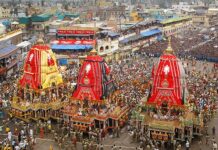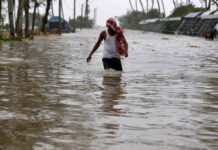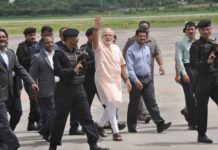New Delhi: Nizam turned slowly along a dusty road in Dera, Gorkha nestled within treacherous Mansiri Himalayan range. Steering through the barren and deserted locality that had taken the hardest hit in the 2015 earthquake, Nizam’s sidekick Attaullah pointed towards Tehfuzul Madrasa. This was one of the safe houses the Pakistani Inter-Services Intelligence (ISI) has been using for sleeper cells to wage a campaign of terror activities targeting India.
Organisations like Tehfuzul served as a perfect front for Indian fugitives and Pakistan-trained operatives to lie low, regroup, arrange material and funds before planning an infiltration into Indian territory. The terror facilitators were under full surveillance. The coordinated operation, a result of the India-Nepal developing mechanism to share high-grade intelligence, had culminated in a covert operation neutralising the most active terror cell linked to Lashkar-e-Taiba (LeT) — that former national security advisor MK Narayanan had once termed as a wholly-owned subsidiary of the ISI.
Months later, two back-to-back explosions in Nepal targeting Indian installations came as a grim reminder that ISI-sponsored terror remnants are still active in the Himalayan country. Although Nepal’s police at this stage sees the hands of a banned communist outfit in two improvised explosive device (IED) attacks at Biratnagar and Sankhuwasabha district, senior Indian intelligence officials are not ruling out the active participation of Jihadi cells operating from various remote parts of Nepal.
On 18 April, unidentified persons carried out a blast at the Indian embassy camp office in Biratnagar damaging the wall-fencing. On 29 April, suspected Jihadi elements targeted office of Arun-III, a 900 MW hydropower project in Sankhuwasabha being developed by India’s Sutlej Jala Vidhyut Nigam, a mini ratna of the power sector. The attack on the power station comes at a time when Nepalese government is preparing to host Prime Minister Narendra Modi, who is expected to lay the foundation stone for the project with his Nepalese counterpart KP Sharma Oli in the second week of May.
Cracking down on terror operation cells
Nizam and his tribe are not new breed in Nepal. They have been operating under the protective cover of the ISI since former Pakistani president General Ayub Khan met King Mahendra in 1962 and the two countries decided to enhance diplomatic ties, providing an opportunity to then ISI chief Brigadier Riaz Hussain to gain a foothold in India’s backyard. The latest intelligence dossiers reviewed by Firstpost show the terrorists exploiting the remote and ideal terrain in Nepal. Several pockets like Bhuta, Ahle, Pachera, Tamgaas, Khairani, Biratnagar and Pokhara have turned into hubs for ISI facilitators, recruiters, sympathisers and financiers.
While the Nepal Police in the days to come, will investigate and interrogate the suspects in the latest explosions, the dossier reveals an unprecedented insight into the Pakistan ISI network and sleeper cells operating in various parts of Nepal. According to the intelligence dossier, the ISI has made arrangements at Biratnagar for accommodation and for providing fake Nepalese resident cards for potential Jihadis travelling to Nepal. Providing details of a suspected module, the dossier said, terror cells had not only provided accommodation for him at a safe house on Karsiya Road in Biratnagar, but also arranged a fake citizenship card within a few days. The handlers keep shifting the recruits from one place to another under the veil of contractual jobs at restaurants and educational institutions.
Since obtaining a Nepalese passport remains a major obstacle, recruits are sent to nondescript places like Ahle village to pick up the Nepali language. Intelligence officials said even the prime suspect in power project blast, the Communist Party of Nepal (CPN) — that has been banned by the US Treasury since 2012 — is getting tacit support from the ISI. “The cells active in Kathmandu facilitate visas for terrorists to move in and out of the country before planning sabotage operations. In the last two years, with the help of the Nepal Police, several modules were neutralised. Many of these terror cells had visited countries like Pakistan and Saudi Arabia on visas sponsored by ISI-backed networks operating in Dammam and Riyadh,” the dossier said.
It is learnt that in January 2018, Indian intelligence agencies handed over a list of five suspected terror-facilitators operating from Biratnagar and Kathmandu, and also involved in drug trafficking, human trafficking and counterfeit Indian currency. A majority of those in diplomatic circles after 2015 had believed that India was losing its grip in the Nepal security scenario before Oli landed at Palam Airport in the first week of April. But, in the security establishment, there have been growing concerns since 2008 that Nepal is turning out to be India’s Achilles heel.
“Concerns were raised immediately after the 2008 Mumbai terror attack that Kashmiri extremists were moving into Nepal and linkages of insurgent groups from the North East were also established with terror cells operating across the border. They were taking advantage of a vulnerable porous border. We have held several rounds of meetings to address the deficiencies, but it is practically not possible to seal every inch of the 1,751-kilometre border. Moreover, the open border has helped to enhance people-to-people contact, but certainly some areas especially in the Terai region are being monitored,” intelligence sources said.
The Ministry of Home Affairs, in its recent report, had said that the main challenges are to check misuse of the open border by the terrorists and criminals for illegal and anti-national activities and to improve security. “To facilitate bilateral dialogue on matters of mutual concern regarding border management, the Governments of India and Nepal have decided to constitute an institutionalised mechanism in the form of home secretary-level talks and a joint working group at the level of joint secretaries. In addition, there is a mechanism of border district coordination committees at the level of district officials of the two countries. These mechanisms serve as platforms for discussing issues of mutual concern such as containing cross-border crimes, smuggling, situations arising out of terrorist activities and national and regional/local levels,” the home ministry had said.
A senior intelligence officer said that in the age of ever-changing dynamics of terrorism, cutting edge intelligence is the only deterrent to thwart terror attacks and stop the IEDs from exploding. He also pointed to a recent crackdown on a syndicate that was smuggling fake Indian currency from Jhapha in Nepal, arguing that money was flown in the country by ISI with an aim to trigger economic terrorism in India.
“Terror groups’ loyalty towards the ISI is well-known. We are working in coordination with Nepal’s security agencies to create a formidable information network to deactivate terror cells being secretly expanded by the Pakistani intelligence organisation,” the intelligence officer said.

 English
English





















